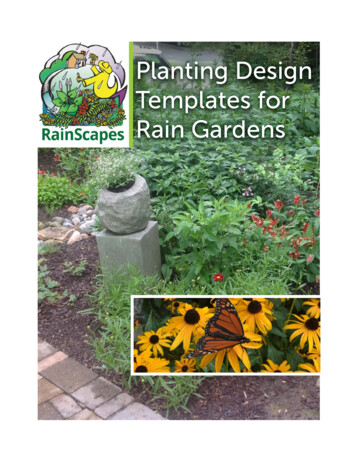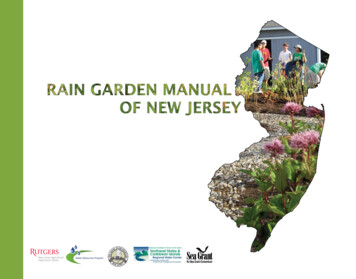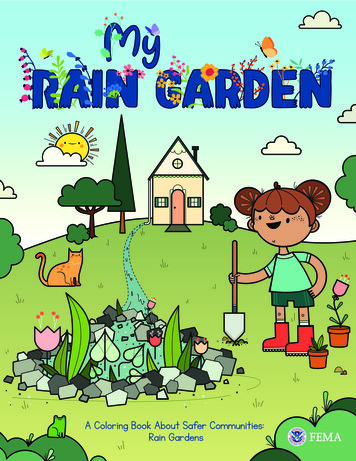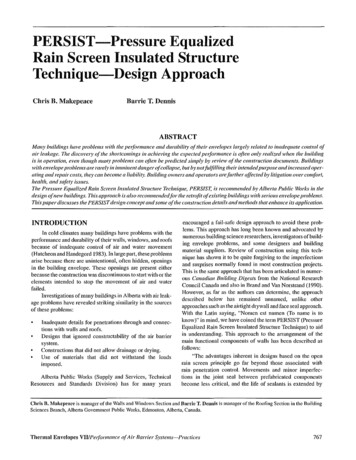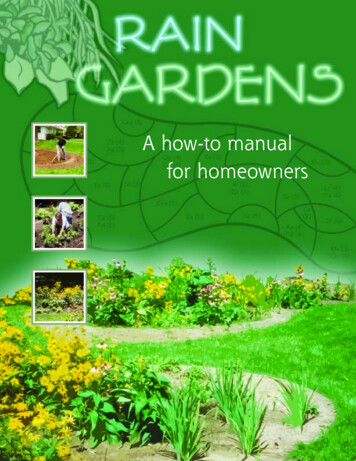
Transcription
A how-to manualfor homeowners
Your personal contribution to cleaner waterHomeowners in many parts of the country are catching on to rain gardens – land-scaped areas planted to wild flowers and other native vegetation that soak up rain water,mainly from the roof of a house or other building. The rain garden fills with a few inchesof water after a storm and the water slowly filters into the ground rather than running offto a storm drain. Compared to a conventional patch of lawn, a rain garden allows about30% more water to soak into the ground.Why are rain gardens important? As cities and suburbs grow and replace forests andagricultural land, increased stormwater runoff from impervious surfaces becomes aproblem. Stormwater runoff from developed areas increases flooding; carries pollutantsfrom streets, parking lots and even lawns into local streams and lakes; and leads to costlymunicipal improvements in stormwater treatment structures.By reducing stormwater runoff, rain gardens can be a valuable part of changing thesetrends. While an individual rain garden may seem like a small thing, collectively theyproduce substantial neighborhood and community environmental benefits. Rain gardenswork for us in several ways:gIncreasing the amount of water that filters into the ground, whichrecharges local and regional aquifers;gHelping protect communities from flooding and drainage problems;gHelping protect streams and lakes from pollutants carried byurban stormwater – lawn fertilizers and pesticides, oil andother fluids that leak from cars, and numerousharmful substances that wash off roofs andpaved areas;gEnhancing the beauty of yards and neighborhoods;gProviding valuable habitat for birds, butterfliesand many beneficial insects.2
Who should use thismanual?This manual provideshomeowners and landscapeprofessionals with theinformation needed todesign and build raingardens on residential lots.Guidelines presented in thismanual can also be used totreat roof runoff at commercial and institutionalsites. However, the manualshould not be used todesign rain gardens forparking lots, busy streetsand other heavily usedpaved areas wherestormwater would requirepretreatment beforeentering a rain garden.Frequently asked questionsDoes a rain garden form a pond?No. The rain water will soak in so the rain garden is drybetween rainfalls. (Note: some rain gardens can bedesigned to include a permanent pond, but that type ofrain garden is not addressed in this publication).Are they a breeding ground for mosquitoes?No. Mosquitoes need 7 to 12 days to lay and hatch eggs,and standing water in the rain garden will last for a fewhours after most storms. Mosquitoes are more likely to layeggs in bird baths, storm sewers, and lawns than in asunny rain garden. Also rain gardens attract dragonflies,which eat mosquitoes!Do they require a lot of maintenance?Rain gardens can be maintained with little effort after theplants are established. Some weeding and watering will beneeded in the first two years, and perhaps some thinningin later years as the plants mature.Is a rain garden expensive?It doesn’t have to be. A family and afew friends can provide the labor. Themain cost will be purchasing the plants,and even this cost can be minimized byusing some native plants that mightalready exist in the yard or in aneighbor’s yard.Rain Gardens – A how-to manual for homeowners3
Step 1 Sizing and Siting the Rain GardenThis section of the manual covers rain gar-den basics – where to put the rain garden,how big to make it, how deep to dig it, andwhat kind of soils and slope are best. Followingthe instructions in this section is the best wayto ensure a successful rain garden project.If you already know the size you want your rainAn extension of PVC pipe helps direct downspout waterto this rain garden.garden to be, then skip ahead to the sectionabout building the rain garden. However, take time read the pointers about location, anddo find the slope of the lawn. If the location has a slope more than about 12%, it’s best topick a different location because of the effort it will take to create a level rain garden.Where should the rain garden go?Home rain gardens can be in one of two places – near the house to catch only roof runoff or farther out onthe lawn to collect water from the lawn and roof. (Figure 1 shows the possible locations on a residential lot.)To help decide where to put a rain garden, consider these points: The rain garden should be at least 10 feet from the house so infiltrating water doesn’tseep into the foundation. Do not place the rain garden directly over a septic system. It may be tempting to put the rain garden in a part of the yard where water alreadyponds. Don’t! The goal of a rain garden is to encourage infiltration, and your yard’s wetpatches show where infiltration is slow. It is better to build the rain garden in full or partial sun, not directly under a big tree. Putting the rain garden in a flatter part of the yard will make digging much easier.For example, a rain garden 10 feet wide on a 10% slope must be 12 inches deep to belevel, unless you import topsoil or use cut and fill.4
Consider your overall landscapeWhen considering placement of your raingarden, design with the end in mind.Carefully consider how the rain garden canbe integrated into existing and futurelandscaping. Also, pay attention to viewsfrom inside the house as well as thoseFigure 1 A rain garden canthroughout the landscape. Determine howfar or how close you want your rain gardento outdoor gathering spaces or other playareas. Why not locate it near a patio whereyou can take advantage of the colors andfragrances for hours on end!rain gardenlengthbe built in the front or backyard. Pick a pleasing shapefor the rain garden. Crescent,kidney, and teardrop shapesseem to work well.raingardenwidthnot within 10'of foundation 30'fromdown spoutroof and lawndrainagearea to backrain gardenroof drainagearea to frontrain gardenclose todown spoutrainngardehtdwiardenrain g gthlenstreetRain Gardens – A how-to manual for homeowners5
Figure 2 Rain gardens should 10'fromfoundation 30'fromdown spoutbermbe located at least 10 feet fromthe house, on a gentle slopethat catches downspout water.closetodownspout 12%slopebermstreetHow big should the rain garden be?The surface area of the rain garden can be almost any size, but time and cost will always be important considerations in sizing decisions. Any reasonably sized rain garden will provide some stormwater runoff control.A typical residential rain garden ranges from 100 to 300 square feet. Rain gardens can be smaller than 100square feet, but very small gardens have little plant variety. If a rain garden is larger than 300 square feet ittakes a lot more time to dig, is more difficult to make level, and could be hard on your budget.The size of the rain garden will depend on how deep the garden will be, what type of soils the garden will be planted in, and how much roof and/or lawn will drain to the garden.Guidelines are not rules This information, along with the sizing factor from the tables onpage 9, will determine the surface area of the rain garden.The sizing guidelinesdescribed in this manual arebased on a goal of controlling100% of the runoff for theaverage rainfall year whilekeeping the size of the raingarden reasonable. Establishing a 100% runoff goal helpscompensate for some of theerrors that creep into thedesign and construction ofany rain garden.Digging with a rented backhoe.6If you follow the guidelines inthe manual and decide thecalculated surface area is justtoo large for your goals, it isperfectly acceptable to makethe rain garden smaller. Therain garden can be up to 30%smaller and still control almost90% of the annual runoff. Onthe other hand, it is fine tomake the rain garden biggerthan the guidelines indicate.
How Deep Should the Rain Garden Be?A typical rain garden is between four and eight inches deep. A rain garden more than eight inches deepmight pond water too long, look like a hole in the ground, and present a tripping hazard for somebodystepping into it. A rain garden much less than four inches deep will need an excessive amount of surfacearea to provide enough water storage to infiltrate the larger storms.No matter what the depth ofthe rain garden, the goal is tokeep the garden level. Digginga very shallow rain garden on asteep lawn will require bringingin extra topsoil to bring thedownslope part of the gardenup to the same height as theup-slope part of the garden. Asthe slope gets steeper, it is easier to dig the rain garden a littledeeper to make it level.downhillstakethe string must be leveluphillstakewidthheightFigure 3 The string should be tied tothe base of the uphill stake, then tied tothe downhill stake at the same level.The slope of the lawn should determine the depth of the rain garden. Find the slope of your lawn byfollowing these steps. (Figure 3 shows how the stakes and string should look.)1. Pound one stake in at the uphill end of your rain garden site and pound the other stakein at the downhill end. The stakes should be about 15 feet apart.2. Tie a string to the bottom of the uphill stake and run the string to the downhill stake.3. Using a string level or the carpenter’s level, make the string horizontal and tie the stringto the downhill stake at that height.4. Measure the width (in inches) between the two stakes.5. Now measure the height (in inches) on the downhill stake between the ground and string.6. Divide the height by the width and multiply the result by 100 to find the lawn’s percentslope. If the slope is more than 12%, it’s best to find another site or talk to a professionallandscaper.Using the slope of the lawn, select the depth of the rain garden from the following options: If the slope is less than 4%, it is easiest to build a 3 to 5-inch deep rain garden. If the slope is between 5 and 7%, it is easiest to build one 6 to 7 inches deep. If the slope is between 8 and 12%, it is easiest to build one about 8 inches deep. EXAMPLETodd measures the length of the string between the stakes; it is 180 inches long. The heightis 9 inches. He divides the height by the width to find his lawn’s percent slope.heightx 100 % slopewidth9 inchesx 100 5% slope180 inchesWith a 5% slope, Todd should build a 6 inch deep rain garden.Rain Gardens – A how-to manual for homeowners7
What type of soils are on the rain garden site?After choosing a rain garden depth, identify the lawn’s soil type as sandy, silty, or clayey. Sandy soils havethe fastest infiltration; clayey soils have the slowest. Since clayey soils take longer to absorb water, raingardens in clayey soil must be bigger than rain gardens in sandy or silty soil. If the soil feels very gritty andcoarse, you probably have sandy soil. If your soil is smooth but not sticky, you have silty soil. If it is verysticky and clumpy, you probably have clayey soil.How big is the area draining to the rain garden?The next step in choosing your rain garden size is to find the area that will drain to the rain garden. As thesize of the drainage area increases so should the size of the rain garden. There is some guesswork in determining the size of a drainage area, especially if a large part of the lawn is up-slope from the proposed gardensite. Use the suggestions below to estimate the drainage area without spending a lot of time.Rain gardens less than 30 feet from the downspout1. In this case, where the rain garden is close to the house, almost all water will come fromthe roof downspout. Walk around the house and estimate what percent of the roof feedsto that downspout. Many houses have four downspouts, each taking about 25% of theroof’s runoff.2. Next find your home’s footprint, the area of the first floor. If you don’t already know it,use a tape measure to find your house’s length and width. Multiply the two together tofind the approximate area of your roof. If the rain gardenis far from thehouse, and youdon’t want a swaleor downspoutcutting across the3. Finally, multiply the roof area by the percent of the roof that feeds to the rain gardendownspout. This is the roof drainage area.Rain gardens more than 30 feet from the downspoutlawn, run a PVC1. If there is a significant area of lawn uphill that will also drain to the rain garden, addthis lawn area to the roof drainage area. First find the roof drainage area using the stepsabove for a rain garden less than 30’ from the downspout.pipe undergroundfrom the downspout to the rainas for a rain2. Next find the area of the lawn that will drain to the rain garden. Stand where your raingarden will be and look up toward the house. Identify the part of the lawn sloping intothe rain garden.garden less than3. Measure the length and width of the uphill lawn, and multiply them to find the lawn area.30 feet from the4. Add the lawn area to the roof drainage area to find the total drainage area.garden. In thiscase do calculationshouse. EXAMPLETodd’s house is 60 feet by 40 feet, so the roof area is 2400 square feet. He estimates thatthe downspout collects water from 25% of the roof, so he multiplies 2400 by 0.25 to get adownspout drainage area of 600 square feet.Roof Area: 60 ft by 40 ft 2400 square ft.Drainage Area: 2400 square ft. x 0.25 600 square ft.8
Simple soil testsTwo small tests can ensure your soil can handle a rain garden: Dig a hole about 6 inches deep where the raingarden is to go and fill the hole with water. Ifthe water takes more than 24 hours to soak in,the soil is not suitable for a rain garden. Take a handful of soil and dampen it with afew drops of water. After kneading the soil in your fingers,squeeze the soil into a ball. If it remains in a ball, then workthe soil between your forefinger and thumb, squeezing itupward into a ribbon of uniform thickness. Allow the ribbonto emerge and extend over the forefinger until it breaksfrom its own weight. If the soil forms a ribbon more thanan inch long before it breaks, and it also feels more smooththan gritty, the soil is not suitable for a rain garden.The map is a starting point for assessing what type of soils you might find in your yard. However, the soil on asmall plot of a yard can be very different from the soils indicated on the map. Use the simple soil test describedhere for a more accurate representation of the soils in the possible rain garden location. More information aboutsampling and testing lawn and garden soils can be obtained at county UW-Extension offices.Using the Rain Garden Size FactorsHaving estimated the drainage area, soil type, and depth for your rain garden, use Table 1 or Table 2 todetermine the rain garden’s surface area. Use Table 1 if the rain garden is less than 30 feet from the downspout, and use Table 2 if it is more than 30 feet from the downspout.Table 1 Rain gardens less than 30 feetTable 2 Rain gardens more than 30 feetfrom downspout.from downspout.3-5 in.deep6-7 in.deep8 in.deepSandy soil0.190.150.08Sandy soil0.03Silty soil0.340.250.16Silty soil0.06Clayey soil0.430.320.20Clayey soil0.10Size Factor, for all depths1. Find the size factor for the soil type and rain garden depth.2. Multiply the size factor by the drainage area. This number is the recommended raingarden area.3. If the recommended rain garden area is much more than 300 square feet, divide it intosmaller rain gardens. EXAMPLETodd’s rain garden is less than 30 feet from the downspout, and his lawn has a 5% slope, sohe will have a 6-inch deep rain garden. His lawn is silty, so Table 1 recommends a size factorof 0.25. He multiplies the downspout drainage area, 600 square feet, by 0.25 to find therecommended rain garden area, 150 square feet.600 square ft. by 0.25 150 square ft.Rain Gardens – A how-to manual for homeowners9
Choose a size that is bestfor your yardRunoff flows into a new rain garden (shown before plants are fully grown).How long and how wide should therain garden be?Before building the rain garden, think about how it will catchwater. Runoff will flow out of a downspout and should spreadevenly across the entire length of the rain garden. The raingarden must be as level as possible so water doesn’t pool atone end and spill over before it has a chance to infiltrate.Remember that these are onlyguidelines. The size of therain garden also depends onhow much money you want tospend, how much room youhave in your yard, and howmuch runoff you want to control. Again, you can reducethe size of your rain gardenby as much as 30% and stillcontrol almost 90% of therunoff. If the sizing table suggests that the rain garden be200 square feet, but there isonly enough room for a140-square-foot rain garden,that’s fine. A smaller rain garden will usually work to control most stormwater runoff,although some bigger stormsmight over-top the berm.The longer side of the rain garden should face upslope; that is, the length of the rain garden should beperpendicular to the slope and the downspout. This way the garden catches as much water as possible.However, the rain garden should still be wide enough for the water to spread evenly over the whole bottomand to provide the space to plant a variety of plants. A good rule of thumb is that the rain garden should beabout twice as long (perpendicular to the slope) as it is wide.When choosing the width of the garden, think about the slope of the lawn. Wide rain gardens and raingardens on steep slopes will need to be dug very deep at one end in order to be level. If the rain garden istoo wide, it may be necessary to bring in additional soil to fill up the downhill half. Experience shows thatmaking a rain garden about 10 feet wide is a good compromise between the effect of slope and how deepthe rain garden should be. A rain garden should have a maximum width of about 15 feet, especially forlawns with more than about an 8 percent slope.To determine the length of the rain garden:1. Pick the best rain garden width for your lawn and landscaping.2. Divide the size of your rain garden by the width to find your rain garden’s length. EXAMPLETodd wants a 10-foot wide rain garden, so he divides 150 by 10 to find the rain gardenlength, 15 feet.rain garden areawidth10 length150 ft2 15 ft10 ft
A noteon tools Step 2Building the Rain GardenNow that the size and place for the rain garden are set, it’stime to get a shovel and start digging. Working alone, it will takeThe followingtools will help inbuilding the raingarden. Some ofthe tools areoptional. Tape measureabout six hours to dig an average-size rain garden. If friends help itwill go much faster, possibly only an hour or two. ShovelsBefore you start digging, callDigger’s Hotline at 1-800-242-8511.If you are building therain garden into anexisting lawn, diggingtime can be reducedby killing the grassfirst. A chemical suchas Round-Up can beused, but a moreenvironmentally Rakes Trowels Carpenter’slevel Wood stakes,at least 2 ftlongfriendly approach isto place black plastic Stringover the lawn untilthe grass dies. Also,the best time to buildthe rain garden is in 2x4 board, atleast 6 ft long(optional)the spring. It will beeasier to dig, and theplants are more likelyto thrive. Small backhoewith caterpillar treads(optional)Rain Gardens – A how-to manual for homeowners11
Levelingthe raingardenOne way to checkthe level of the raingarden is to just“eyeball” it. To do itmore accurately follow these steps: When the wholearea has beendug out to aboutthe right depth,lay the 2x4 boardin the rain gardenwith the carpenter’s level sittingon it. Find thespots that aren’tflat. Fill in the lowplaces and digout the highplaces. Move the boardto different placesand differentdirections, fillingand digging asnecessary to makethe surface level. When the raingarden is as levelas you can get it,rake the soilsmooth.12The perimeter of a rain garden is defined with string before digging.Digging the rain gardenWhile digging the rain garden to the correct depth, heap the soil around the edgewhere the berm will be. (The berm is a low “wall” around three sides of the rain gardenthat holds the water in during a storm.) On a steeper lawn the lower part of the raingarden can be filled in with soil from the uphill half, and extra soil might need to bebrought in for the berm.Start by laying string around the perimeter of your rain garden. Remember that theberm will go outside the string. Next, put stakes along the uphill and downhill sides,lining them up so that each uphill stake has a stake directly downhill. Place one stakeevery 5 feet along the length of the rain garden.Start at one end of the rain garden and tie a string to the uphill stake at ground level.Tie it to the stake directly downhill so that the string is level. Work in 5-foot-wide sections,with only one string at a time. Otherwise the strings will become an obstacle.Start digging at the uphill side of the string. Measure down from the string and dig untilyou reach the depth you want the rain garden to be. If the rain garden will be four inchesdeep, then dig four inches down from the string. Figure 4 shows how.If the lawn is almost flat, you will be digging at the same depth throughout the raingarden and using the soil for the berm. If the lawn is steeper, the high end of the raingarden will need to be dug out noticeably more than the low end, and some of the soilfrom the upper end can be used in the lower end to make the rain garden level.Continue digging and filling one section at a time across the length of your rain gardenuntil it is as level as possible.In any garden, compost will help the plants become established and now is the time tomix in compost if needed. Using a roto-tiller can make mixing much easier, but isn’tnecessary. If you do add compost, dig the rain garden a bit deeper. To add two inchesof compost, dig the rain garden one to two inches deeper than planned.
Figure 4 Where to dig and where to put the soil you’ve dug.a. Between 3% and 8% slope lawndownhillstakeuphillstakestringBeforeDigging5% euphillstakeold lawnsurfacestringberm6"base of raingarden10'uphillstakeb. Greater than 8% slope lawndownhillstakeBeforeDiggingstring10% slopeAfterDigging downhillstakestartdigginghere8"uphillstakeold lawnsurfacestringberm8"12"4"10'Rain Gardens – A how-to manual for homeowners13
downspoutuphilluphillbermdownhillFigure 5 The top of the downhill part of the bermshould come up to the same elevation as the entryto the rain garden at the uphill end.Making the BermWater flowing intro the rain garden will naturally try toOn a gentle slope, soil from digging out the gardencan be used to create the berm. This rain garden isrun off the downhill edge. A berm is needed to keep4 inches deep.the water in the garden, The berm is a “wall” across thebottom and up the sides of the rain garden. The berm will need to be highest at the downhill side. Up thesides of the rain garden, the berm will become lower and gradually taper off by the time it reaches the topof the rain garden. Figure 5 shows how the berm should look.On a flat slope there should be plenty of soil from digging out the rain garden to use for a berm. On asteeper slope, most of the soil from the uphill part of the rain garden was probably used to fill in the downhill half, and soil will have to be brought in from somewhere else. After shaping the berm into a smoothridge about a foot across, stomp on it. It is very important to have a well-compacted berm, so stomp hard.The berm should have very gently sloping sides; this helps smoothly integrate the rain garden with thesurrounding lawn and also makes the berm less susceptible to erosion.To prevent erosion, cover the berm with mulch or plant grass. Use straw or erosion-control mat to protectthe berm from erosion while the grass is taking root.If you don’t want to plant grass or mulch over the outside of the berm, you can also plant dry-tolerantprairie species. Some potential berm species are prairie dropseed, little bluestem, prairie smoke, blue-eyedgrass, prairie phlox, and shooting star.Note: If the downspout is a few feet from the entry to the rain garden, make sure the water runs into thegarden by either digging a shallow grass swale or attaching an extension to the downspout.14
Tips for designing an attractive rain gardenWhile rain gardens are a highly functional way to help protect water quality, they are alsogardens and should be an attractive part of your yard and neighborhood. Think of therain garden in the context of your home’s overall landscape design. Here are a few tips:When choosing native plants for the garden, it is important to consider the height of eachplant, bloom time and color, and its overall texture. Use plants that bloom at differenttimes to create a long flowering season. Mix heights, shapes, and textures to give thegarden depth and dimension. This will keep the rain garden looking interesting even whenfew wildflowers are in bloom.When laying plants out, randomly clump individual species in groups of 3 to 7 plants toprovide a bolder statement of color. Make sure to repeat these individual groupings tocreate repetition and cohesion in a planting. This will provide a more traditional formallook to the planting.Try incorporating a diverse mixture of sedges, rushes, and grasses with your floweringspecies (forbs). This creates necessary root competition that will allow plants to followtheir normal growth patterns and not outgrow or out-compete other species. In naturalareas, a diversity of plant types not only adds beauty but also create a thick undergroundroot matrix that keeps the entire plant community in balance. In fact, 80% of the plantmass in native prairie communities is underground. Once the rain garden has matured andyour sedges, rushes and grasses have established a deep, thick root system, there will beless change in species location from year to year, and weeds will naturally decline.Finally, consider enhancing the rain garden by using local or existing stone, ornamentalfences, trails, garden benches, or additional wildflower plantings. This will help give thenew garden an intentional and cohesive look and provide a feeling of neatness that theneighbors will appreciate.Rain Gardens – A how-to manual for homeowners15
Step 3Planting and Maintainingthe Rain GardenPlanting the rain garden is the fun part! A number of plantingdesigns and lists of suggested plants are included at the end of thispublication. Use these for ideas, but don’t be afraid to be creative –there’s no single best way to plant a rain garden. Anyone who hasever done any gardening will have no problem planting arain garden, but a few basic reminders are listed below.Planting the rain gardenSelect plants that have a well established root system. Usually oneor two-year-old plants will have root systems that are beginning tocircle or get matted. (Note: use only nursery-propagated plants; donot collect plants from the wild).Make sure to have at least a rough plan for which plants will beplanted where. Lay out the plants as planned one foot apart in a gridpattern, keeping them in containers if possible until they are actuallyplanted to prevent drying out before they get in the ground.Dig each hole twice as wide as the plant plug and deep enoughto keep the crown of the young plant level with the existing grade(just as it was growing in the cell pack or container). Make sure thecrown is level and then fill the hole and firmly tamp around theroots to avoid air pockets.Apply double-shredded mulch evenly over the bed approximately twoinches thick, but avoid burying the crowns of the new transplants.Mulching is usually not necessary after the second growing seasonunless the “mulched look” is desired.Stick plant labels next to each individual grouping. This will helpidentify the young native plants from non-desirable species (weeds)as you weed the garden.As a general rule plants need one inch of water per week. Waterimmediately after planting and continue to water twice a week(unless rain does the job) until the plugs are established. You shouldnot have to water your rain garden once the plants are established.Plugs can be planted anytime during the growing season as long asthey get adequate water.16Fire safetyMake sure burning is allowedin your locale. If so, be sure tonotify the local fire departmentand obtain a burn permit ifneeded. It’s also wise – not tomention neighborly – to makesure the neighbors know thatyou’re burning and that allsafety precautions are beingtaken. Basic fire precautionsinclude: Make sure there is afire-break (non-burnable area, such as turfgrass) at least 10-feetwide surrounding thearea to be burned. Never burn onwindy days. Never leave anactively burning fireunattended. Keep a garden hosehandy in case fire strayswhere it is not wanted.Also have a metal leafrake in hand to beatout flames that creepbeyond the burn zone.
What does a raingarden cost?Maintaining the rain gardenWeeding will be needed the first couple of years. Remove byhand only those plants you are certain are weeds. Try to get outall the roots of the weedy plants. Weeds may not be a problem inthe second season, depending on the variety and tenacity ofweeds present. In the third year and beyond, the native grasses,sedges, rushes, and wildflowers will begin to mature and willout-compete the weeds. Weeding isolated patches might still beneeded on occasion.After each growing season, the stems and seedheads can be leftfor winter interest, wildlife cover and bird food. Once springarrives and new growth is 4-6-inches tall, cut all tattered plantsback. If the growth is really thick, hand-cut the largest plants andthen use a string trimmer to mow the planting back to a height ofsix to eight inches. Dead plant material can also be removed witha string trimmer or weed whacker (scythe) and composted or disposed of as appropriate.The best way to knock back weeds and st
No. Mosquitoes need 7 to 12 days to lay and hatch eggs, and standing water in the rain garden will last for a few hours after most storms. Mosquitoes are more likely to lay eggs in bird baths, storm sewers, and lawns than in a sunny rain garden. Also rain gardens attract dragonflies, which eat mosquitoes! Do they require a lot of maintenance?





